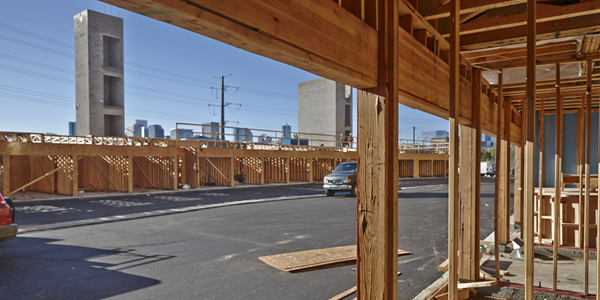Builders expect that a building product will provide solid, reliable performance for multifamily construction. But when that same product also provides significant savings over other framing options, builders take notice.
As the multifamily housing market booms, builders are increasingly turning to glulam to save time and money.
Contractors used glulam for the structural beams in The Glen at University Park, a complex of 107 three-story condominiums for students at California State University’s San Bernardino campus. Amir Deihimi, PE, president of Core Structure Inc., said that their switch to glulam saved 20 to 30 percent over alternative framing options.
Material and Labor Savings From Using Engineered Products
When builders use engineered products such as glulam beams and I-joists, they save not only in material costs but labor as well.
Designers for Galt Place estimate that they saved more than $1 million by converting to a wood podium for the senior housing complex in Galt, California. They achieved the savings through lower material costs combined with soft-cost savings from faster construction, easier handling and having fewer trades on site.
At Westend in Denver, an urban garden-style apartment complex, builders used glulam beams as headers over windows, doors, and garage doors, which saved money over alternative options. The beams’ 3-1/2- and 5-1/2-inch widths matched framed wall dimensions; alternative options would have required tripling up—and therefore extra money and labor. “With a project this large, you really start to realize labor savings; it gets multiplied across the project,” says Eric Hanson, PE, SE, president of Anchor Engineering.
Glulam provides strength and stability in floor and roof systems and as columns for multifamily projects. While most builders think of glulam as an appropriate product to use for projects with just a few stories, it’s increasingly being used for four- and even five-story structures.
In some examples of mid-rise, mixed-use construction, such as Galt Place, architects are designing structures with two to five stories of wood framing over a wood podium in place of the traditional concrete podium. Using a wood podium offers two key benefits: it reduces overall construction costs and time, and lighter-weight wood framing materials provide a more sustainable, less massive building that can save in foundation costs.
And the possibilities don’t end there. Architects in British Columbia are now code-permitted to design multifamily properties with wood framing up to six stories tall, a trend that could spread to the U.S. as familiarity grows.
Strength and Versatility
Glulam offers a lightweight framing solution to even the most complex multifamily structural designs. With greater strength and stiffness than dimension lumber, these engineered beams can easily accommodate long spans—especially important for large multifamily projects.
Glulam’s span capabilities were instrumental for the Winfield Gate project in Houston, which consists of 22 four-story luxury townhomes. “There’s no question that the glulam helped us achieve our design goals,” says Andy Suman, partner at developer and builder Röhe & Wright. He noted that the glulam was able to span each unit from wall to wall, eliminating the need for interior load-bearing walls and therefore preserving open floor plans and allowing flexible layouts.
At Denver’s Westend apartment complex, glulam played a key role in a different design challenge: creating the cantilevers and bump outs that were essential to the varied exterior façade. “Nobody wants a plain box anymore,” says Leo Brown, vice president of Carmel Partners and CP Construction. “The more ins and outs there are, the happier renters are, but the harder it is to frame. The glulam beams helped us meet those needs.”
Time = Money
Product availability is an important factor in enabling builders to quickly respond to the high demand for multifamily housing. Glulam beams are available in local markets in widths that match standard 2x4 and 2x6 wall construction; they’re also available in I-joist-compatible depths and in other commonly-used dimensions.
“I had been under the impression that glulam was always custom and had a long lead time,” Deihimi said. “But the manufacturer had standard sizes and I-joist-compatible depths stocked at the lumberyard; there was no waiting for an order because it was all in stock.”
While the multifamily housing market is booming, developers are anxious to get their projects completed as quickly as possible, because only then can their cash flow turn positive. Wood framing gives builders a cost-effective, reliable, quick-to-install building solution. In project after project, builders are seeing how engineered wood products like glulam are helping them save money and build quickly and efficiently.





